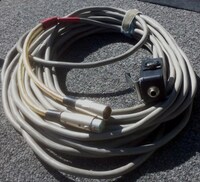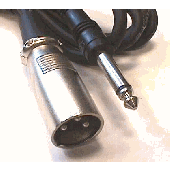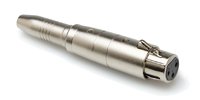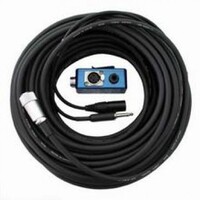 You wouldn't think about using a camera without any type of viewfinder, so why would you want to boom a shot without headphones? The boom operator must be able to monitor not only the audio that his/her microphone is picking up, but also all of the audio from any open mics in play during the shot.
You wouldn't think about using a camera without any type of viewfinder, so why would you want to boom a shot without headphones? The boom operator must be able to monitor not only the audio that his/her microphone is picking up, but also all of the audio from any open mics in play during the shot.
The importance of a boom operator being able to hear the shotgun mic is critical. How else can he judge the effective aim and distance of his microphone? The ability to hear is especially crucial when it comes to position and angle of the mic when you have to split between actors. Playing a louder actor slightly off axis and playing the softer actor directly on axis of the boom microphone is a viable way of balancing out the voices without affecting the standing volume of the background.
The boom operator also needs to be able to monitor all of the open microphones being used in the vicinity of the boom mic, so as to be able to avoid phasing problems caused by double miking. Anytime two microphones can hear the same audio, and are mixed to the same track -- you risk adding a lot of echo and hollowness to the dialogue due to the wave interference of the two audio signals. Whenever you are using additional microphones in the live mix, such as a second boom mic, plant mics, or lavaliers -- the boom operator needs to be aware of which mics are being played at the time.
Note that if you are only using lavaliers as ISO feeds, and not adding them to your live mix, then they should NOT be added to the boom operators monitor feed. However, if you select to utilize a lavalier in your live production mix (say, an actor steps away from the boom), then the boom operator must be able to hear when you add that lav to your mix.
All of the microphones that are being opened and closed by the faders in your production mix should be heard by the boom operator.
To achieve this goal, we use a special microphone cable that does double duty: it carries the signal from the boom mic down to the mixing panel; and at the same time it conveys a headphone feed back to the boom operator. These special cables are referred to as duplex or boom cables.
The simplest form of a boom cable is to lash a headphone extension cable onto a microphone cable. Diligent shopping can come up with a straight headphone extension cable of 15 to 25 feet in length. Tape that to a matching length of XLR microphone cable and you have a primitive, but functional, boom cable.
You can plug the boom operator's headphone cable into a Y splitter at the headphones jack of the mixing panel or recorder. Some mixing boards offer separate jacks for talkback & monitoring. Personally, I prefer to plug my boon operators into a post fader Aux Send. Post Fader means that the audio mimics what I do with the faders controlling my live mix. If the faders are closed, then no audio to the boom operator. As I open and close mics during the scene -- that is what comes across the headphone feed. The individual controls for the Aux Send allow me to remove any mics or feeds from the headphones, so that the boom operator does not need to suffer through a loud reference tone generator, or the forced laughter of audience mics, or the ear splitting roar of a sound effects plant mic. If I need to call immediate attention to the presence of a mic (such as a plant mic or a lav that I need to use), I can wig-wag the Aux send volume control for that particular mic. It will only affect the headphone feed, but not the recording.
 Headphone extension cables, however, are generally too short for use on a film set. You can make a longer cable by 69-ing two XLR microphone cables of equal length. Simply add a monaural 1/4-inch to XLRm adapter cable to the "panel" end of the headphone feed, in order to mate with the Aux Send jack. At the boom operator's end, you can add an XLR female to 1/4-inch stereo (aka TRS) jack for the headphones to plug into.
Headphone extension cables, however, are generally too short for use on a film set. You can make a longer cable by 69-ing two XLR microphone cables of equal length. Simply add a monaural 1/4-inch to XLRm adapter cable to the "panel" end of the headphone feed, in order to mate with the Aux Send jack. At the boom operator's end, you can add an XLR female to 1/4-inch stereo (aka TRS) jack for the headphones to plug into.
What if you could combine these two mic cables into one, thicker cable that would be more convenient? That is what professionals use! The major microphone cable manufacturers offer what is referred to as duplex cables. A duplex cable means that there are two sets of independent microphone cables (three wires each: plus, minus, and shield) or at least five individual wires (plus, minus, plus, minus, common shield) all housed within one outer sheath.
 Audio suppliers such as PSC, Trew/Coffey, Location Sound Corp, and others all offer custom built duplex cables for use on production.
Audio suppliers such as PSC, Trew/Coffey, Location Sound Corp, and others all offer custom built duplex cables for use on production.
The most common duplex cables are 50 to 75 feet in length, and feature a permanently attached 1/4-inch mono plug at the panel end for the headphone feed. The other connector at the panel end would be, of course, an XLRm connector for the signal from the boom microphone. AT the boom operator's end, there is a small metal box with a belt clip. The box features an XLRf connector, where you would plug in the mic cable from the boompole. The box would also have a 1/4-inch jack, for connection to headphones. Some boxes even offer a volume control for the headphones!
Duplex cables can be fixed length, or breakaway. The metal box, instead of being permanently attached, connects via a multi-pin coupler, such as a five pin XLR connector. To extend the length of the duplex cable, simply insert a section of appropriately wired duplex line.
Personally, I do my duplex cables a little differently. I never permanently attach a 1/4-inch plug to the panel end of my cable. Instead, I leave both pigtails as XLR connectors (one male, and one female). Then I attach a 1/4-inch plug to XLRm adapter to the headphone side. That allows me the option of using a different connector, depending on the mixing panel or recorder being used. I could attach an 1/8-inch adapter for use with ENG panels, or even leave it as an XLR for use with some boards.
To extend my duplex cable to any length, I only need to insert two standard XLR microphone cables. True, I have two cables instead of one for the first section of my duplex run, but that part of a cable run on a large set is pretty much a locked down stretch. The part of the duplex cable that needs to be one sheath is the section closest to the boom operator, since that is where the movement takes place.
You want to make sure that your boom operator monitors in mono, not stereo. Hearing different mics or audio in each ear can be very distracting to a boom person. Always check out your duplex cable and adapters to make sure that when you plug stereo headphones in at the boom operator end, the result is mono audio in both ears. If you are only hearing sound in one ear (a very common problem with rented cables), you can remedy the situation with a stereo 1/4-inch to mono 1/4-inch simple adapter. If you own the duplex cables, ask your technician to rewire them for mono.